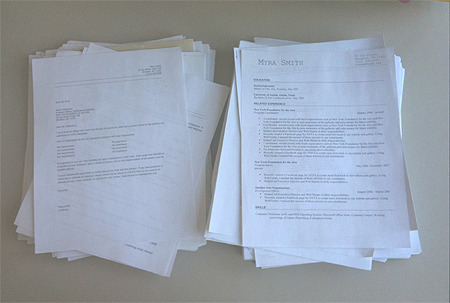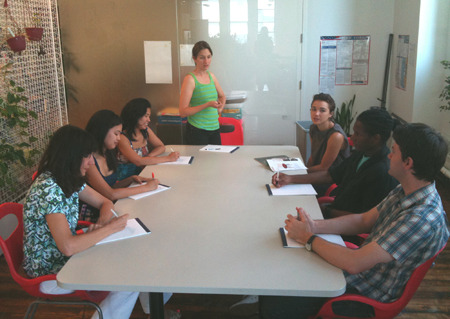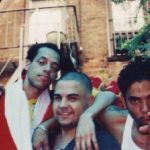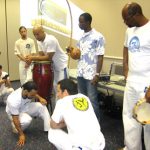The Business of Art: Be Creative — Finding a Job in the Arts
A NYFA Meeting.
Whether you are a recent graduate, suddenly out of work or looking to make a career transition, it’s a tough job market out there and the art world is no exception. The following is a guide of key strategies in finding a perfect opportunity to landing the job.
Your search begins with defining both what you’re looking for and what your qualifications are. The arts and culture sector consists of a large range of industries including galleries, nonprofits, museums, magazines, architectural firms, performing venues, and music publishing companies just to name a few. If you are just beginning your professional career, you may want to explore as many opportunities as possible to see which ones will be the most interesting to you. Many skills and job responsibilities will be transferable across disciplines and companies. At the same time, every organization—whether it is an exhibition space or a literary agency—has a unique language, mission, and set of qualifications among their employees. Throughout your process, think about the various ways that your skills fit each specific niche that you’re applying to.
Where To Look
- Online Job Boards. These are the most widely used recruiting tools for employers and there are many different ways to effectively take advantage of them. NYFA offers an extensive nationwide job board (https://www.nyfa.org/jobs) exclusively for jobs and internships in the arts and culture sector, and there are countless others including ones with your local arts councils. Many sites are art and culture related or discipline-specific and many are large with a limited amount of arts jobs listed. If you’re just starting your search, cast a wide net. Bookmark sites with relevant listings and check them on a daily basis. Subscribe to their RSS feeds. Several of the large job boards, such as Yahoo! HotJobs and Monster, offer the ability for users to post their résumés online for employers to search. This may seem like a shot in the dark, but I landed a full-time gallery job by their HR Director finding my résumé online (the position was never even posted).
- Email Groups and Listservs. These are (usually) free groups that are used for industry-specific discussion and are great resources for applicants to hear about new positions. They are also a good starting place to learn about key issues or news in a particular field. I recommend Museum-L for the museum sector and University of Buffalo Poetics for writing and literature.
- College Career Services Departments/Alumni Associations. This is often an underused free resource for college graduates. Your university’s career services department can not only help you find an opportunity or connect you with alumni, but they can help you structure a cover letter and résumé. Many universities offer these services online or on the phone for graduates that are unable to visit. At the same time, get involved with your college’s alumni association. Attend alumni networking events or join their group on LinkedIn, a social networking site for professionals.
- Tell People That You’re Looking. Tell your friends, your parents’ friends, your neighbor, your former employer, and the mailman—you’ll be surprised at who knows who! A job search can be exhausting for both applicants and employers and this could be your way of getting your name in front of a potential employer before an opening is even posted.
Get Your Foot In the Door
- Volunteer or Intern at An Organization or Field that You’re Interested In (and Do a Good Job). Think of internships as learning experiences where you develop practical on-the-job business skills that will better prepare you for joining the work force. Whether your internship is paid or unpaid, don’t take it for granted (i.e. come prepared, anticipate your supervisor’s needs, etc.). For many recent graduates, your internship supervisor may be your only professional reference (a job-seeking necessity) and in some cases, they may even offer you a job. Roughly a third of NYFA’s staff worked as interns immediately before being offered permanent positions. This is not true for all organizations, but in the art world in particular, you will find similar situations more frequently than not and it makes sense. Current interns already know the organization, require less training, and have already proved their abilities and work ethic.
- Informational Interviews. Research institutions or professionals you admire and potentially want to work with and request an informational interview with them. This is your chance to pick the brain of someone who is currently working a job you may eventually want. At the very least, they are good practice for a job interview. Be gracious and come prepared. Ask them what their workday consists of, what skills are required for it (i.e. what skills you want to acquire), and what their professional and educational background is (i.e. how did they get their job). Always follow up with a thank-you note. Informational interviews can sometimes lead to a job or can create a lasting professional relationship.
- Networking or Industry Events. This is a requirement in the art world even when you are not job seeking. Many organizations, including NYFA, offer networking events which are usually informal gatherings focused around a specific artist or discipline. These are great opportunities to meet others and learn more about a particular field. At the same time, almost all organizations offer events that include a social component. While they may not be implicitly called networking events, approach them as if they are. I’m not suggesting that you bring your résumé, but use any opportunity (readings, performances, gallery openings, etc.) to exchange business cards and talk to people in the industry. If you had a particularly pleasant conversation with someone working in your field, it’s appropriate for you to follow up with them via email reiterating your interest in getting involved with their organization.

The Application Process (Do’s & Don’ts):
Most position openings will start with a job description and will ask you for a cover letter, résumé and in some cases, a writing sample. When choosing a writing sample, imagine the type of writing you will be doing in the position and choose a sample that demonstrates your abilities in this regard. If you are applying for an opportunity that has not been posted, search job descriptions of similar positions to aid you in writing your cover letter. Once you are further along in the interviewing process, employers will ask you for professional references.
DO…Print out the job description and read it with a highlighter. Employers put key words and phrases into their listings because they are expecting applicants to answer them.
DON’T…Confuse a cover letter with your biography.
DO…Be as concise as possible in all written material and create a cover letter that specifically demonstrates how your skills and qualifications fit the listed job requirements.
DON’T…Recycle cover letters for different jobs. While there will be some overlap, the language should be unique for each position.
DO…Your research. Almost all organizations have websites which list their mission and recent and upcoming activities. Reference these events in your cover letter and match your interests with an organization’s values.
DON’T…List a professional reference without contacting them first and updating them about your job search.
DO…Keep several variations of your résumé so that you can easily update them for new opportunities. If you are an artist, you may already have an artist’s résumé which should be different from your work résumé. Tailor and edit them to include qualifications that are relevant to the position.
DON’T…Call the organization if the listing says “No Phone Calls.” You want employers to remember your name, but not as the person who doesn’t follow instructions.
DO…Practice a mock interview with a friend. Employers will often want to meet with qualified applicants immediately so you must always be prepared.
DON’T…Limit yourself to applying to only newly posted jobs. While you should try to apply to an open position as soon as possible, most employers take their listings down once the position is filled or once they have received enough résumés. If the position is still listed and you fit the qualifications, by all means, apply.
Making An Impression: The Interview
The interviewing process varies for each position, but generally speaking, you will have at least two before a job offer is made. Employers tend to call in a larger number of applicants into the initial interview phase and two to three candidates during the second round. At the first interview, you may meet with an HR manager, the position supervisor, and/or their assistant. During the second round of interviews, you should expect to meet with the position supervisor and/or the Executive Director or head of the company.
-
Show up to your interview five to 10 minutes early, not after and not before (they won’t know what to do with you) with multiple copies of your cover letter and résumé.
-
Be gracious and approachable with absolutely every staff member you meet including assistants and receptionists. Coworkers talk and you don’t want to lose out on a great opportunity because you snubbed an intern.
-
Look professional. Many creative organizations will be casual in their attire, however it is not appropriate for you to wear shorts or jeans to an interview—even if that is what the person interviewing you is wearing. If possible, try and gauge what the office dress code is beforehand and dress slightly more formal than that. If you are unsure, wear a suit or separates with a blazer.
-
Research the company and field in advance. Employers are looking for candidates that are knowledgeable about their organization and their industry. If you walk into a gallery interview and don’t know the names of some of the artists they represent, you are unprepared.
-
Take notes, particularly when they are describing the job responsibilities. When it’s your turn to speak, use this opportunity to express how your skills and background align with the position’s core goals.
-
Be interested and ask targeted questions possibly about the structure of the department and the organization’s upcoming plans and events.
-
Ask what the next steps are and what their hiring timeline is; however, do not be pushy about it. Never ask if you got the job during the interview or if they can notify you by a specific date.
-
Always send a handwritten thank-you note immediately after an interview that reiterates your interest and background. If an employer says they are hiring right away, send an email thank-you note the next morning followed by a handwritten thank-you note.
If they make you an offer…
Congratulations! Most offers are made over the phone, however it may also happen during a second interview so be prepared. Ask them about your start date, benefits, and the timing for performance reviews. If the salary is not what you were expecting, ask them if it is negotiable, realizing that there is less flexibility for this in the art world.
If you receive a rejection…
Respond kindly to them, thanking them for the opportunity and encouraging them to keep you in mind for future openings. Don’t get discouraged. Remember, the hiring staff was impressed with your qualifications, cover letter, and résumé to meet with you in the first place so you’re halfway there. Think of unsuccessful interviews as practice for that final interview that will lead to your ideal position.
Very few applicants get the first job they applied to. A strong job search does not consist of just one of these strategies, but is a solid combination of most of them. Be creative and assertive in identifying a range of opportunities, properly presenting yourself both in paper and in person and always following up.
Most importantly, remember to network. The art world is small and gets even smaller once you start advancing within a specific industry. Networking will keep you engaged in the field and will be your most important tool in your continual career development. Attend an opening, watch a performance, listen to a panel discussion, introduce yourself, and keep in contact with new connections. Surrounding yourself with culture will not only help you get a job, it will remind you why you want to work in the arts to begin with.
Maria Villafranca is the Senior Program Officer, Online Resources at the New York Foundation for the Arts (NYFA) where she manages all aspects of NYFA Classifiedsand NYFA Source. She holds a B.A. in Art History and English from Rutgers University and a M.F.A. in Fiction from Brooklyn College.





